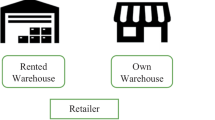Abstract
This paper deals with a retailer who sells single perishable product in two bins. The fresh items are sold at a list price in the primary bin and the unsold items that have reached a certain allowed age are transferred to the secondary bin to be sold at a discount price. It is assumed that the demand is affected by inventory level, selling price, product freshness, and demand leakage caused by the price difference of two bins. Also, products are sold under mixed issuing policy which is defined as a weighted sum of Last-In-First-Out and First-In First-Out issuing policy. With the objective of maximizing the retailer’s profit, we develop mathematical models for the following two cases: (1) opening primary shop only and (2) opening both primary shop and secondary shop. Noting that the objective function is too complicated to possess a closed-form optimal solution, a solution procedure is developed based on Tabu search. The validity of the model is shown by solving an example problem and the sensitivity study is performed on the system parameters.
Similar content being viewed by others
References
Abad P. L. (1988) Determining optimal selling price and lot size when the supplier offers all-unit quantity discount. Decision Sciences 19: 622–634
Adachi Y., Nose T., Kuriyama S. (1999) Optimal inventory control policy subject to different selling prices of perishable commodities. International Journal of Production Economics 60(1): 389–394
Al-Sultan K. S., Al-Fawzan M. A. (1997) A tabu search Hooke and Jeeves algorithm for unconstrained optimization. European Journal of Operational Research 103: 198–208
Baker R. C., Urban T. L. (1998) A deterministic inventory system with an inventory-level-dependent demand rate. Journal of the Operational Research Society 39: 823–831
Benjamin M., Chris K. A. (2008) Revenue management for low-cost provider. European Journal of Operational Research 188: 258–272
Cohen M. A., Peckelman D. (1978) LIFO inventory systems. Management Science 11(24): 1150–1162
Das K., Maiti M. (2003) Inventory of a differential item sold from two shops under single management with shortages and variable demand. Applied Mathematical Modeling 27: 535–549
Datta T. K., Pal A. K. (1990) A note an inventory model with inventory-level dependent rate. Journal of Operational Research Society 41(10): 971–975
Fujiwara O., Soewandi H., Sedarage D. (1997) An optimal ordering and issuing policy for a two-stage inventory system for perishable products. European Journal of Operational Research 99: 412–424
Glover F. (1990) Tabu search: A tutorial. Interfaces 20(4): 74–94
Goyal S. K., Gunasekaran A. (1995) An integrated production-inventory-marketing model for deteriorating items. Computers & Industrial Engineering 28(4): 755–762
Hwang H., Hahn K. H. (2000) An optimal procurement policy for items with an inventory-level-dependent demand rate and fixed lifetime. European Journal of Operational Research 127: 537–545
Kar S., Bhunia A. K., Maiti M. (2001) Inventory of multi-deteriorating items sold from two shops under single management with constraints on space and investment. Computers & Industrial Engineering 28: 1203–1221
Larson P. D., DeMarais R. A. (1990) Psychic stock: An independent variable category of inventory. International Journal of Physical Distribution and Logistics Management 20(7): 28–34
Lee G. R., Oh Y. H., Hwang H. (2008) A discount policy for perishable items sold from two shops. Journal of the Korean OR/MS Society 33(2): 137–151
Levin R. I., McLaughlin C. P., Lamone R. P., Kottas J. F. (1972) Productions/Operations Management: Contemporary Policy for Managing Operating Systems. McGraw-Hill, New York
Pal S., Goswami A., Chaudhuri K. S. (1993) A deterministic inventory model for deteriorating items with stock-dependent demand rate. International Journal of Production Economics 32: 219–299
Ruibin B., Graham K. (2008) A model for fresh produce shelf-space allocation and inventory management with freshness-condition-dependent demand. INFORMS Journals on computing 29: 78–85
Shinn S. W., Hwang H., Park S. S. (1996) Joint price and lot size determination under conditions of permissible delay in payments and quantity discounts for freight cost. European Journal of Operational Research 91(3): 528–542
Silver E. A., Peterson R. (1985) Decision Systems for Inventory Management and Production Planning (2nd ed.). Wiley, New York
Urban T. L. (1992) An inventory model with an inventory-level-dependent rate and relaxed terminal conditions. Journal of the Operational Research Society 43(7): 721–724
Urban T. L. (2005) Inventory models with inventory-level-dependent demand: A comprehensive review and unifying theory. European Journal of Operational Research 162(3): 792–804
Wolfe H. B. (1968) A model for control of style merchandise. Industrial Management Review 9(2): 69–82
Zhang M., Bell P. C. (2007) The effect of market segmentation with demand leakage between market segments on a firm’s price and inventory decisions. European Journal of Operational Research 182: 738–754
Author information
Authors and Affiliations
Corresponding author
Rights and permissions
About this article
Cite this article
Han, S., Oh, Y. & Hwang, H. Retailing policy for perishable item sold from two bins with mixed issuing policy. J Intell Manuf 23, 2215–2226 (2012). https://doi.org/10.1007/s10845-011-0567-8
Received:
Accepted:
Published:
Issue Date:
DOI: https://doi.org/10.1007/s10845-011-0567-8




